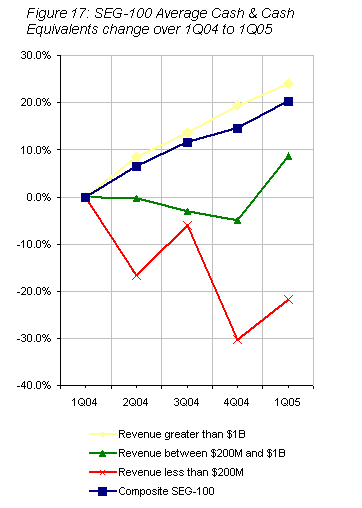|
|
| Home - Software M&A Review |
Software M&A - Q1 Software Industry Equity Report
continued... page 3 |
SOFTWARE MERGERS AND ACQUISITIONS: TRENDS AND INSIGHT
Valuation can be tricky these days. More than ever, beauty is in the eyes of the beholder. We’ve noted in prior Quarterly Reports the relationship between valuation and buyer motive, and how valuation closely (and unsurprisingly) correlates with the degree of buyer need (i.e., perceived strategic importance) and the perceived strategic fit. We’ve also noted in prior Reports how much median deal valuations vary by software product category. It’s rare today to see a supply chain or CRM transaction carry a multiple greater than 1.5x TTM revenue, and rarer still to see a security software deal at less than 3.5x. But there are other factors at work here, as well, which help to explain both the wide variance in deal valuations we’re seeing today, and the erratic quarter-to-quarter variances in median deal multiples.
As we’ve already quantified above, size matters in the software industry, especially when it comes to mergers and acquisitions. We’ve long observed a tendency of larger companies to pay more for a strategic acquisition than a small or mid-cap public software company. We’ve also observed that smaller privately-held software companies tend to exit at lower valuations than privately-held software companies with greater revenue. We decided to prove and quantify our observations.
Our analysis of software M&A transactions in 2004 and 1Q05 reveals buyers with annual revenue in excess of $1 billion paid a median multiple of 4.0x seller’s TTM revenue, while software companies with annual revenue less than $200 million paid a 1.7x TTM revenue multiple. Mid-cap software companies with revenues between $200 million and $1 billion paid a median multiple of 3.1x seller’s TTM revenue.
Do larger software companies spend more because they have more to spend? Oftentimes, yes. And it’s a phenomenon we expect to see continue. We analyzed the balance sheets of every public software company comprising the SEG-100 to help us better understand the changing M&A landscape. Software companies with revenue greater than $1 billion saw aggregate cash and cash equivalents grow 24.1% from 1Q04 to 1Q05 (Figure 17). However, SEG-100 companies with revenue less than $200 million saw cash decrease 21.7% over the same time period.

It’s not that money is no object to the billion dollar software company - most of them today spend M&A dollars cautiously. Yet once the large industry players are convinced of the strategic value of owning a particular privately-held ISV, they have the cash and they’re not afraid to spend it. Small and mid-cap public software companies, however, are compelled by market forces to acquire, but are currently draining rather than building cash reserves. Consequently most are considerably more tight-fisted at the negotiating table and more circumspect about strategic fit.
Innately, most privately-held software company investors and principals have long known they’ll cash out at a higher valuation selling to one of the industry behemoths than a mid-tier player. Probably true, but easier said than done. Our analysis of all reported software industry M&A valuations in 2004 and 1Q05 reveals that software companies with revenues greater than $1 billion accounted for only 24% of the transactions, while buyers with revenues less than $200 million were responsible for 58% of the M&A activity. Software companies with revenues greater than $200 million and less than $1 billion accounted for 18% of the transactions.
The size of the seller also matters when it comes to M&A exit valuations. Software companies with TTM revenue greater than $100 million sold at a median multiple of 2.9x, while software developers (virtually all privately-held) with TTM revenue less than $20 million sold at a median multiple of 2.2x. Software companies with revenue between $20 million and $100 million sold for a median exit valuation of 2.7x TTM revenue.
All of this suggests that privately-held software companies are likely to realize their highest exit valuation if they achieve a certain critical mass and attract a greater than billion dollar revenue public software company buyer. However, the industry behemoths purchase far fewer companies and often eschew small (<$25 million) privately-held software developers, preferring to acquire more bang for the buck in the form of significant incremental revenue and earnings accretion. In order to warrant the very large software company’s investment of time and resources to consummate a small transaction, the target must be viewed as both highly strategic and necessary.
Multi-transaction buyers were active in the first quarter. Some of this quarter’s most active buyers:
Altiris
Pedestal Software
Tonic Software
BMC Software
OpenNetwork
Calendra
Click Commerce
Optum
ChannelWave
Digi International
Embebidos
FS Forth-Systeme GmbH
Infor Global Solutions
MAPICS
Mercia Software
IBM
Ascential Software
SRD
Jack Henry & Associates
Tangent Analytics
RPM Intelligence
|
Microsoft Corporation
ContentGuard
Professional Advantage
Groove Networks
En'tegrate Software
Sybari Software
Neoware Systems
eSeSIX Computer (Thintune business)
Mangrove Systems
TeleVideo (thin client business)
Oracle
Oblix
Retek
Qpass
Encorus (mobile payments software business)
ucp morgen
SAP
DCS Automotive
iLytix Systems
SecureD Services
Chameleon Technology
Allegent Technology
SS&C Technologies
Financial Models Company
Achievement Technologies
|
...more...

|
|


|

